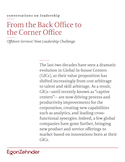The last two decades have seen a dramatic evolution in Global In-house Centers (GICs), as their value proposition has shifted increasingly from cost arbitrage to talent and skill arbitrage. As a result, GICs—until recently known as “captive centers”— are now driving process and productivity improvements for the corporation, creating new capabilities such as analytics, and leading crossfunctional synergies. Indeed, a few global companies have gone further, bringing new product and service offerings to market based on innovations born at their GICs.
With GICs now showing themselves capable of not just cutting costs and improving efficiency but also contributing to strategic capabilities and revenue generation, these entities are reaching a critical inflection point. Forward-thinking companies are recognizing the value of GICs by giving them a seat at the table where broader operational or technology strategy is determined, and giving them a greater degree of ownership in shaping and managing the global operating platform. This is certainly a significant development — one that could hardly have been imagined a decade ago — but we do not believe this is the end of the journey. To completely realize the benefit of a GIC’s contribution to an organization’s global operational capability, it is necessary to fully integrate the GIC into the enterprise value chain. The GIC must now think of itself as a core part of how the organization delivers value to its customers, and not just an operations engine. This shift will require closer linkage between the reporting lines and process flows of the GIC and the organization’s other functions and businesses, as well as a meaningful and high-impact integration at the leadership level.
Such a move, however, carries fundamental implications for the responsibilities and capabilities required of successful GIC leaders. No longer will operations and headcount management be the benchmark for performance: when GICs are full strategic players, managing cost, quality and productivity becomes just basic hygiene. In this new environment, GICs will hold more accountability for, and ownership of, tangible business outcomes and metrics. This will significantly broaden their sphere of responsibility and influence within the organization.
Heightened expectations — and opportunities
For the GIC leader of tomorrow, meeting these heightened expectations will require a widening of perspective and experience well beyond what is commonly understood. Today, helping a GIC leader “gain a strategic perspective” or “see the big picture” often means creating secondment opportunities to headquarters, establishing cross-border reporting lines or finding other ways to create exposure to the full range of the organization’s products and services. But this will not be enough going forward. In the future, the GIC will have to make the same epic shift to customer centricity that parent organizations in all industries are now undertaking. This shift requires organizations to grapple with matters at the very heart of why the enterprise exists, the brand and customer proposition it supports and the culture and values that drive the organization globally.
As it happens, GIC leaders are uniquely positioned to provide insight into these issues. Sitting as they do at the controls of the “engine room” of the company, they have unparalleled access to almost all links of the business’ value chain. From this vantage point, they can begin to answer questions that are critical for aligning the GIC function with the organization’s larger evolution towards more competitive and efficient business models:
- What can the GIC do to help support the company’s strategy?
- How can the GIC be more responsive in delivering the company’s brand promise to end customers or consumers?
- How does the GIC ensure that it is correctly balancing enterprise risks vs. operational and product innovation?
- What operational and technology assets owned by the company can be deployed in new markets?
- How can the GIC build differentiation across the entire value chain of the company’s processes?
Taking the next (C-level) step
These are, of course, not the concerns of a back-office manager but of a contemporary corporate leader with a multidimensional business orientation. That being the case, it is but a short step to envision GIC leadership as another pipeline in which to develop corporate CXO talent. The breadth of strategic and operational challenges being addressed and resolved by the GIC leaders, as well as their proximity to the operational underpinnings of the company, will prepare them well for broader and more strategic CXO roles within the global entity.
Organizations looking to identify and develop GIC leaders capable of rising to the position’s new challenges (and be credible CXO contenders) cannot leave the process to chance; rather, they must rethink the recruitment and development strategy associated with the role, starting with a fundamental revision of the role’s competency profile.

Having the right competency profile is essential for assessing a candidate’s leadership abilities. But evaluating a candidate only against competencies has a critical blind spot: it assumes that the future will be much like the present, because competencies provide no guidance in benchmarking how someone will respond to seismic shifts in business models, economic conditions, opportunities and challenges — exactly the sort of environment in which organizational leaders find themselves today. Thus it is possible that someone who has the right competencies and presents himself or herself well may falter when asked to lead during times of dramatic change. Similarly, an overreliance on competencies can cause an organization to bypass a candidate who may seem underprepared today but who, with the right mentoring, could grow into the role.
In Egon Zehnder’s analysis of the assessments of thousands of senior executives, we discovered that those who flourished in the face of volatility, complexity, uncertainty and ambiguity shared four traits, which collectively we call potential. The four elements of potential are:

Charting a path forward
Benchmarking candidates against both the right competencies and the elements of potential provides a framework to identify not just tomorrow’s GIC leaders, but GIC leaders with the ability to advance to a C-suite position in the global organization. With this in mind, organizations can assess their current GIC talent management strategy by asking the following four diagnostic questions:
1. What are the competencies of the GIC leadership team today?
2. How do they compare to other internal CXO candidates and to external benchmarks?
3. What gaps must be addressed so that GIC leaders can become viable C-suite candidates?
4. What programs and processes will help them get there?
With its higher strategic profile, a GIC has all the innate requirements to create a potentially rich lode of leadership talent, both for itself and for the organization’s CXO pipelines. Committing to the investment required — in identifying, retaining and developing these individuals, and in creating the required structural environment for them to flourish and grow — will deliver increasingly significant returns on investment for future-oriented businesses.






